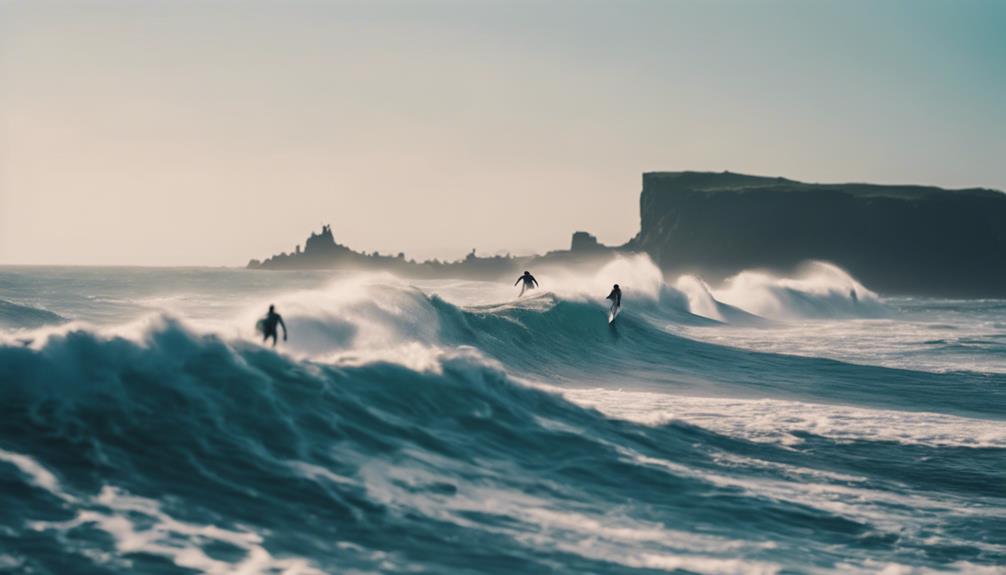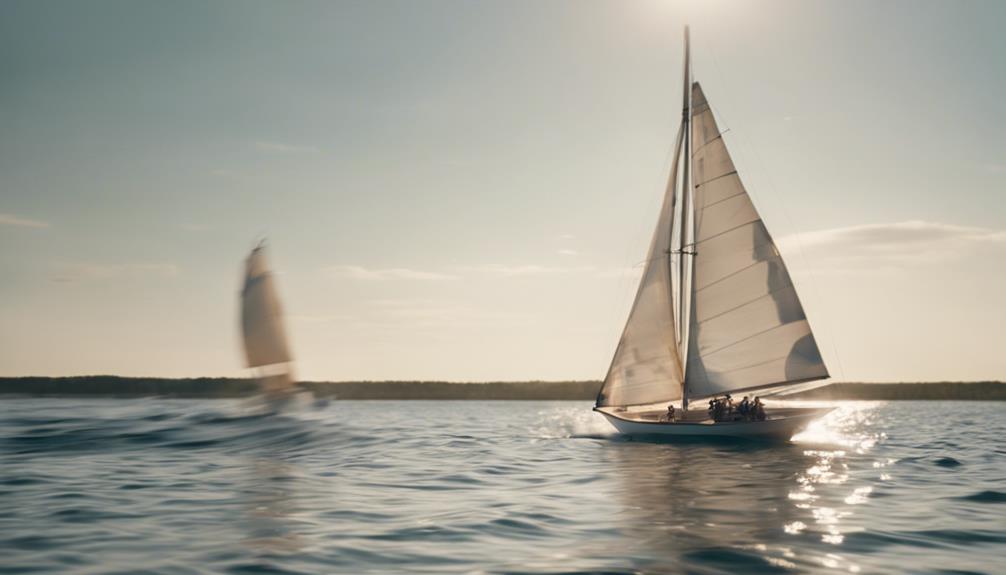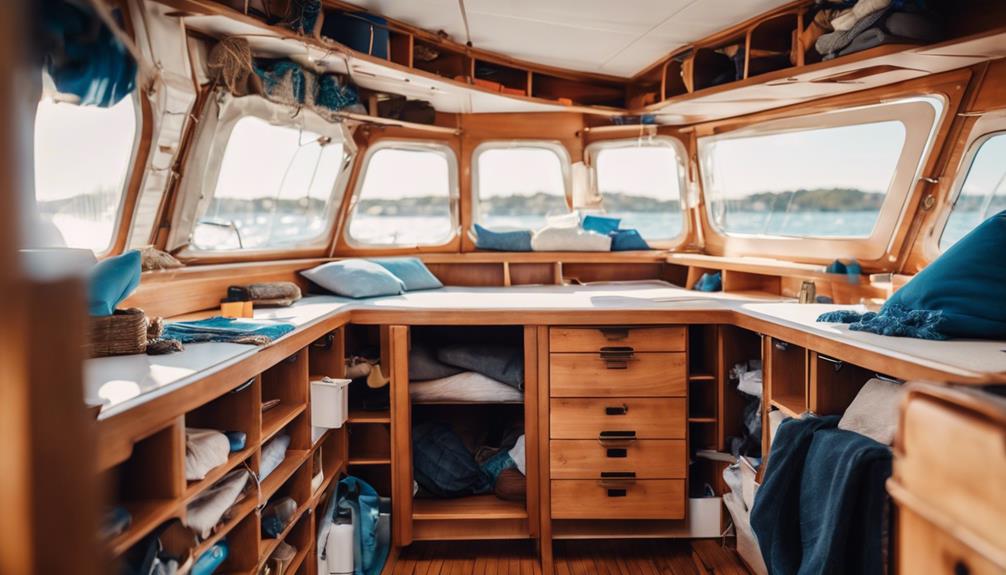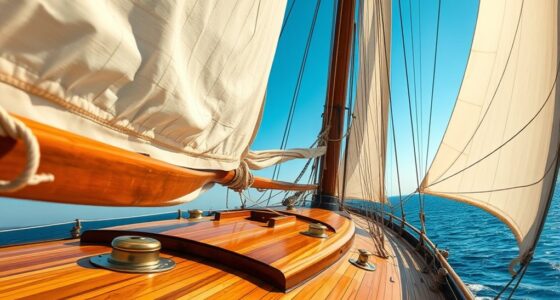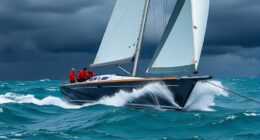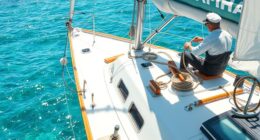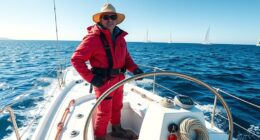The biggest sailboat you can comfortably sail alone ranges between 30 to 40 feet. This size strikes the perfect balance between adventure and manageability. If you're heading out for coastal cruising, aim for boats around 30 to 33 feet. For offshore journeys, consider 32 to 34 feet for better stability and control. With modern features like furling mainsails and electric winches, handling becomes much easier. Plus, sailing solo opens up unparalleled freedom and personal growth. Want to discover the top models and tips to enhance your solo sailing experience? There's much more to explore!
Key Takeaways
- The ideal sailboat size for solo sailing is between 30 to 40 feet, balancing comfort and manageability.
- Recommended models include the Alerion 28 for performance and the Seascape 24 for overnight trips.
- Larger vessels over 40 feet can complicate solo sailing due to maneuverability challenges.
- Essential equipment like autopilots and electric winches enhances efficiency and reduces physical strain during solo voyages.
Ideal Sailboat Size Range
When you're considering solo sailing, the ideal sailboat size usually falls between 30 to 40 feet for the best balance of manageability and comfort.
Sailboats in the 30 to 33-foot range are particularly popular among solo sailors, as they offer a great combination of space and ease of handling. These boats are manageable for steering coastal cruising routes, allowing you to explore beautiful shorelines without feeling overwhelmed.
While larger boats over 40 feet may offer additional amenities, they often present challenges in maneuverability, especially for solo sailing. If you're venturing into offshore sailing, vessels between 32 to 34 feet are recommended, striking an excellent balance between stability and ease of control.
Smaller boats, around 27 to 28 feet, can be suitable for short trips but may require creative stowage solutions for extended voyages.
As you think about your sailing adventures, keep in mind that larger boats, particularly those over 60 feet, can complicate berthing and handling. Selecting the right size is essential for enjoying your solo journey, ensuring you can manage your vessel confidently while maximizing comfort.
Benefits of Solo Sailing

Solo sailing offers you unparalleled freedom, allowing you to make decisions on the fly without needing to consult a crew. This independence can greatly reduce stress, making your time on the water more enjoyable. As you navigate your own sailing adventures, you'll find that the solitude encourages self-discovery, providing the perfect backdrop for deep contemplation and reflection.
Engaging in solo sailing fosters personal growth, as you face challenges and learn from each experience. You'll develop essential sailing skills, mastering navigation, weather patterns, and seamanship—all while building your confidence. The sense of achievement that comes from successfully managing your vessel alone is incredibly rewarding, reinforcing your independence.
Without a crew, you also form a more intimate relationship with your boat. You can tailor your sailing experience to your preferences, enhancing your comfort and enjoyment on each journey.
Ultimately, solo sailing allows you to explore not just the world around you, but also the depths of your own capabilities, transforming your adventures into a journey of personal discovery. Embrace the freedom and growth that solo sailing brings, and set sail on your own unique path.
Essential Equipment for Solo Voyages

Equipping your sailboat with the right gear can make all the difference in guaranteeing a safe and enjoyable solo adventure on the water. For solo sailors, essential equipment includes reliable autopilots, which reduce the physical strain of steering and allow you to navigate hands-free during long passages. This feature is priceless, especially when you need to manage other tasks on board.
In addition, electric winches are a game-changer for sail handling. They increase efficiency, making it easier to trim sails and manage lines without excessive physical effort. This is particularly beneficial on larger vessels where manual winching can be intimidating.
Don't overlook the importance of a well-designed reefing system, as it allows you to quickly reduce sail area in changing wind conditions, enhancing safety and performance.
Communication devices, such as satellite phones and onboard Wi-Fi, are essential for staying connected. They let you share your sailing routes with trusted contacts, which adds an extra layer of safety.
Lastly, confirm you have adequate safety gear, including stout webbing straps and tethers to prevent falls overboard, and always wear a life jacket while sailing alone.
Sailboat Design and Features

Choosing the right sailboat design and features can greatly enhance your solo sailing experience, making it more enjoyable and manageable. For a solo sailor, a sailboat between 30 to 40 feet strikes the perfect balance between comfort and performance.
Modern designs often include furling mainsails and self-tacking jibs, simplifying sail handling and reducing the physical strain on you.
An effective deck layout is fundamental; it minimizes obstacles and enhances mobility, allowing you to move freely while sailing alone. Advanced rigging systems, like lazyjacks and electric winches, are essential in facilitating sail management and boosting overall efficiency during your voyages.
Furthermore, look for features in a sailboat that promote proper weight distribution and stability. This greatly impacts handling, especially in varying weather conditions, making design considerations critical for solo sailors.
Prioritizing these elements will help guarantee that your sailing adventures aren't just manageable but also enjoyable, allowing you to focus on the thrill of the open water. When you combine light weight with these smart features, you'll have a sailboat that meets your solo sailing needs perfectly.
Safety Measures for Solo Sailors

Safety is paramount for anyone venturing out alone on the water, so wearing a life jacket and using jacklines to stay securely attached to the boat is essential. Your safety gear should include stout webbing straps and tethers, along with well-maintained equipment, to guarantee a quick response in emergency situations.
Establishing a reliable communication plan is vital. Share your sailing route and timeline with a trusted contact, and equip your vessel with satellite phones or Wi-Fi for emergencies. This way, someone will always know your whereabouts.
To enhance your skills and preparedness, consider attending safety courses. These courses can equip you with the knowledge needed to handle emergencies effectively at sea.
Additionally, regularly practicing reefing techniques and sail changes in various wind conditions helps you stay proficient and ready for unexpected challenges. The more familiar you're with your boat and its capabilities, the better you can respond to any situation that arises.
Handling Different Weather Conditions

As you master safety measures for solo sailing, understanding how to handle different weather conditions becomes equally important for your overall preparedness on the water. Experience sailing in various weather patterns will enhance your ability to sail solo and confidently navigate challenges.
Here are some key strategies for effective handling:
- Practice Reefing Techniques: Familiarize yourself with reefing techniques in varying wind conditions. This helps you manage sail size and maintain control during sudden changes.
- Monitor Weather Patterns: Stay vigilant and keep an eye on changing weather. Recognizing patterns can help you anticipate storms.
- Prepare for Heavy Weather: Have a plan for using storm sails or heaving to if conditions worsen. Heavy weather can complicate handling larger boats, so guarantee your vessel's handling capability aligns with your skills.
- Utilize Technology: Use weather apps and communication devices for real-time updates. This enhances safety and keeps you connected with support networks during solo voyages.
Recommended Sailboats for Solo Sailing

What makes a sailboat ideal for solo sailing often comes down to size, design, and your personal comfort level on the water. Generally, a size boat between 30 and 40 feet is recommended, with many experienced sailors preferring vessels around 30 to 33 feet for their manageability.
For sporty day trips, you might consider the Fareast 19, which offers agility and fun on the water. If you're planning to spend the night, the Seascape 24 is a perfect choice, providing both comfort and overnight capabilities. For those interested in solo racing, the Alerion 28 stands out due to its exceptional performance.
While larger boats like the Cal 40 can be single-handedly managed by experienced sailors, you'll want to guarantee you have the right skills and preparation. Keep in mind that boats over 40 feet often become complex to operate alone, which can lead to challenges in maneuverability.
For day sailing, older IOR designs and lightweight boats around 12-16 feet strike a great balance, offering performance and ease of handling for solo sailors.
Tips for Improving Sailing Skills

Improving your sailing skills requires consistent practice and a willingness to learn from both successes and challenges on the water. Whether you're sailing solo on smaller boats or venturing out on larger vessels, here are four tips to enhance your abilities:
- Enroll in sailing courses focused on solo sailing techniques. These classes build foundational skills and boost your confidence in maneuvering a sailboat alone.
- Regularly practice essential maneuvers, like tacking and gybing. Try these in varying wind conditions to improve your responsiveness and adaptability at sea.
- Familiarize yourself with your boat's systems and equipment. Knowing how to efficiently operate and maintain your sailboat will enable you to troubleshoot issues independently.
- Utilize sailing simulations and apps to practice navigation and weather assessment. These tools sharpen your decision-making skills before heading out on the water alone.
Community and Support for Solo Sailors

Building a strong network of fellow solo sailors can greatly enhance your sailing experience, providing invaluable support and shared wisdom on the open water. Joining a sailing club not only gives you access to a fleet of boats but also fosters a sense of community among solo sailors. Here, you can exchange tips and stories that can make your journeys more enjoyable.
Participating in local sailing events and regattas encourages camaraderie and helps you connect with others who share your passion. These gatherings allow you to bond over shared experiences, making it easier to navigate the challenges of sailing alone. Engaging with online sailing forums further expands your network, where you can seek advice and find emotional support from fellow solo sailors.
Mentorship plays a key role in this community; learning from experienced sailors can provide you with valuable insights to navigate the complexities of sailing solo. Many communities even advocate for hybrid sailing approaches, allowing solo sailors to alternate between solo and crewed passages, promoting safety while enriching your overall experience.
Embrace the community, and you'll find your solo sailing adventures more fulfilling than ever.
Navigating Challenges at Sea

Steering challenges at sea requires sharp focus and quick decision-making, especially when sailing solo. The physical demands of larger boats can easily overwhelm you if you're not prepared. To navigate these challenges effectively, keep these key factors in mind:
- Unexpected Weather: Always stay alert for sudden weather changes. Heavy conditions can complicate managing your vessel, increasing risks.
- Safety Measures: Use harnesses and jacklines to prevent falls overboard. In rough seas, staying attached to your boat is vital.
- Continuous Fatigue Management: Solo sailing is taxing both physically and mentally. Establish a routine to rest and recharge, which helps prevent decision-making errors.
- Essential Maneuvers: Practice maneuvers like reefing and sail changes in various wind conditions. Being prepared boosts your confidence and readiness.
Frequently Asked Questions
What Is the Largest Sailboat You Can Sail Alone?
The largest sailboat you can realistically manage alone is about 40 feet. Your experience and comfort level matter greatly, so choose a size that balances stability and ease of handling for your solo adventures.
What Is the Largest Sailing Yacht Without Crew?
“Bigger isn't always better.” When you're considering the largest sailing yacht without crew, aim for around 40 feet. Prioritize stability and ease of handling to guarantee a safe and enjoyable solo sailing experience.
What Is the Largest Sailboat Single Mast?
The largest single-masted sailboat you can typically handle solo is around 40 to 45 feet. Choosing features like furling mainsails and self-tacking jibs can make your sailing experience easier and more enjoyable.
Who Holds the Record for Sailing Solo Around the World?
Like a comet blazing through the night sky, François Gabart holds the record for sailing solo around the world. He completed the journey in just 42 days, 16 hours, and 40 minutes in December 2017.
What are the challenges of sailing a large sailboat alone and how to overcome them?
Sailing a large sailboat alone comes with unique challenges for even the largest solo sailers. One major hurdle is handling the boat’s immense size and weight without assistance. To overcome this, solo sailors can use advanced technology like autopilot systems and learn to anticipate and adapt to changing weather conditions.
Conclusion
In the grand tapestry of solo sailing, finding your perfect sailboat can be a delightful adventure.
Embrace the freedom of the open waters, knowing that with the right size and features, you can chart your own course.
While challenges may occasionally whisper in your ear, your preparation and skills will keep you afloat.
So, hoist those sails, relish the journey, and let the winds of possibility carry you toward unforgettable horizons.
Happy sailing!


